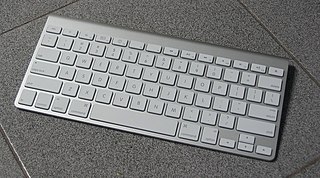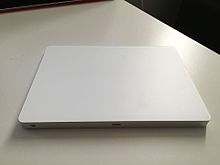
A touchpad or trackpad is a pointing device featuring a tactile sensor, a specialized surface that can translate the motion and position of a user's fingers to a relative position on the operating system that is made output to the screen. Touchpads are a common feature of laptop computers as opposed to using a mouse on a desktop, and are also used as a substitute for a mouse where desk space is scarce. Because they vary in size, they can also be found on personal digital assistants (PDAs) and some portable media players. Wireless touchpads are also available as detached accessories.

Apple Inc. has designed and released dozens of keyboard models since the introduction of the Apple II in 1977. The current models in use are dual-mode keyboards with integrated batteries: Magic Keyboard, and Magic Keyboard with Numeric Keypad. Both share a similar look and feel, based on a very thin aluminum chassis and laptop-style low-profile keys, sitting much closer to the tabletop than traditional keyboard designs.

The Apple Wireless Keyboard is a wireless keyboard built for Macintosh computers and compatible with iOS devices. It interacts over Bluetooth wireless technology and unlike its wired version, it has no USB connectors or ports. Both generations have low-power features when not in use. It was discontinued on October 13, 2015, and was succeeded by the new Magic Keyboard.

The MacBook Pro is a line of Mac laptops made by Apple Inc. Introduced in January 2006, it is the higher-end lineup in the MacBook family, sitting above the consumer-focused MacBook Air. It is currently sold with 13-inch, 14-inch, and 16-inch screens, all using Apple silicon M-series chips.

Apple Inc. has designed and manufactured several models of mice, trackpads and other pointing devices, primarily for use with Macintosh computers. Over the years, Apple has maintained a distinct form and function with its mice that reflect their design languages of that time. Apple's current external pointing devices are the Magic Mouse 2 and Magic Trackpad 2.

The Magic Mouse is a multi-touch wireless mouse that is manufactured by Foxconn and sold by Apple Inc.. The first-generation Magic Mouse was released on October 20, 2009, and introduced multi-touch functionality to a computer mouse. Taking after the iPhone, iPod Touch, and multi-touch MacBook trackpads, the Magic Mouse allows the use of multi-touch gestures and inertia scrolling across the surface of the mouse, designed for use with macOS.

Lightning is a proprietary computer bus and power connector created and designed by Apple Inc. and introduced on September 12, 2012, to replace its predecessor, the 30-pin dock connector. The Lightning connector is used to connect Apple mobile devices like iPhones, iPads, and iPods to host computers, external monitors, cameras, USB battery chargers, and other peripherals. Using 8 pins instead of 30, Lightning is much smaller than its predecessor, which was integrated with devices like the iPhone 4 and the iPad 2. The Lightning plug is symmetrical, so it can be inserted into a Lightning receptacle in either orientation. The plug is indented on each side to match up with corresponding points inside the receptacle to retain the connection.

The iPad Air 2 is the second-generation iPad Air tablet computer designed, developed, and marketed by Apple Inc. It was announced on October 16, 2014, alongside the iPad Mini 3, both of which were released on October 22, 2014. The iPad Air 2 is thinner, lighter and faster than its predecessor, the first-generation iPad Air, and features Touch ID with the height, width and screen size the same as the iPad Air.

The 12-inch MacBook is a discontinued Mac laptop made by Apple Inc., which sat between the MacBook Air and MacBook Pro in Apple's laptop lineup.

The iPad Pro is a premium model of Apple's iPad tablet computer. It runs iPadOS, a tablet-optimized version of the iOS operating system.
Apple Pencil is a line of wireless stylus pen accessories designed and developed by Apple Inc. for use with supported iPad tablets.

The Siri Remote is a remote control released by Apple with the Siri-capable fourth generation and later Apple TV. The Siri Remote is the successor to the original Apple Remote.

The Magic Keyboard is a family of wireless computer keyboards manufactured by Foxconn under contract for Apple Inc. The keyboards are bundled with the iMac and Mac Pro, and also sold as standalone accessories. They replaced the Apple Wireless Keyboard product line. Each Magic Keyboard model combination has a compact or full-size key layout for a specific region, a function key or Touch ID sensor next to F12, and color scheme variant.

iPadOS 13 is the first major release of the iPadOS mobile operating system developed by Apple Inc. for their iPad line of tablet computers. The successor to iOS 12 on those devices, it was announced at the company's 2019 Worldwide Developers Conference (WWDC) on June 3, 2019, as a derivation from iOS, with a greater emphasis on multitasking and tablet-centric features. It was released on September 24, 2019. It was succeeded by iPadOS 14, released on September 16, 2020.

The Magic Keyboard for iPad is a computer keyboard for the iPad Pro and iPad Air, produced by Apple. It was announced in March 2020 with an original release date of May 2020, but it was subsequently made available to order in mid-April. Deliveries started later that month. It is available alongside the Smart Keyboard and Smart Cover. A white version was released on April 20, 2021.

The iPad Air , informally referred to as iPad Air 4, is a tablet computer designed, developed, and marketed by Apple Inc. It was announced by Apple on September 15, 2020. Pre-orders began on October 16, 2020, and shipping began a week later on October 23, 2020 alongside the iPhone 12 and iPhone 12 Pro. The device closely resembles the design of the 11-inch iPad Pro and has several features that were previously exclusive to the iPad Pro line, such as support for Magic Keyboard and the second-generation Apple Pencil. It is available in five colors: Space Gray, Silver, Rose Gold, Green, and Sky Blue.

The iMac M1 is an all-in-one desktop Mac made by Apple Inc. It is the first iMac with Apple silicon, and sports a new, more colorful design, a 24-inch screen, and an Apple M1 chip. It was released on May 21, 2021, replacing the 21-inch and 27-inch Intel iMacs.

The sixth-generation iPad Mini is a tablet computer in the iPad Mini line, designed, developed and marketed by Apple Inc. It was announced on September 14, 2021, and released on September 24, 2021, alongside the ninth-generation iPad, iPhone 13 and iPhone 13 Pro. Its predecessor, the fifth-generation iPad Mini, was discontinued on the same day. It is available in four colors: Space Gray, Starlight, Pink, and Purple.

The iPad 10.9-inch is a tablet computer developed and marketed by Apple Inc. as the successor to the ninth-generation iPad. It was announced on October 18, 2022, and was released on October 26, 2022.

The sixth-generation iPad Pro, colloquially known as the M2iPad Pro, is a line of iPad tablet computers developed and marketed by Apple Inc. It was announced on October 18, 2022 and was released on October 26, 2022. It is available with the same screen size options as its predecessor: 11-inch and 12.9-inch.


















